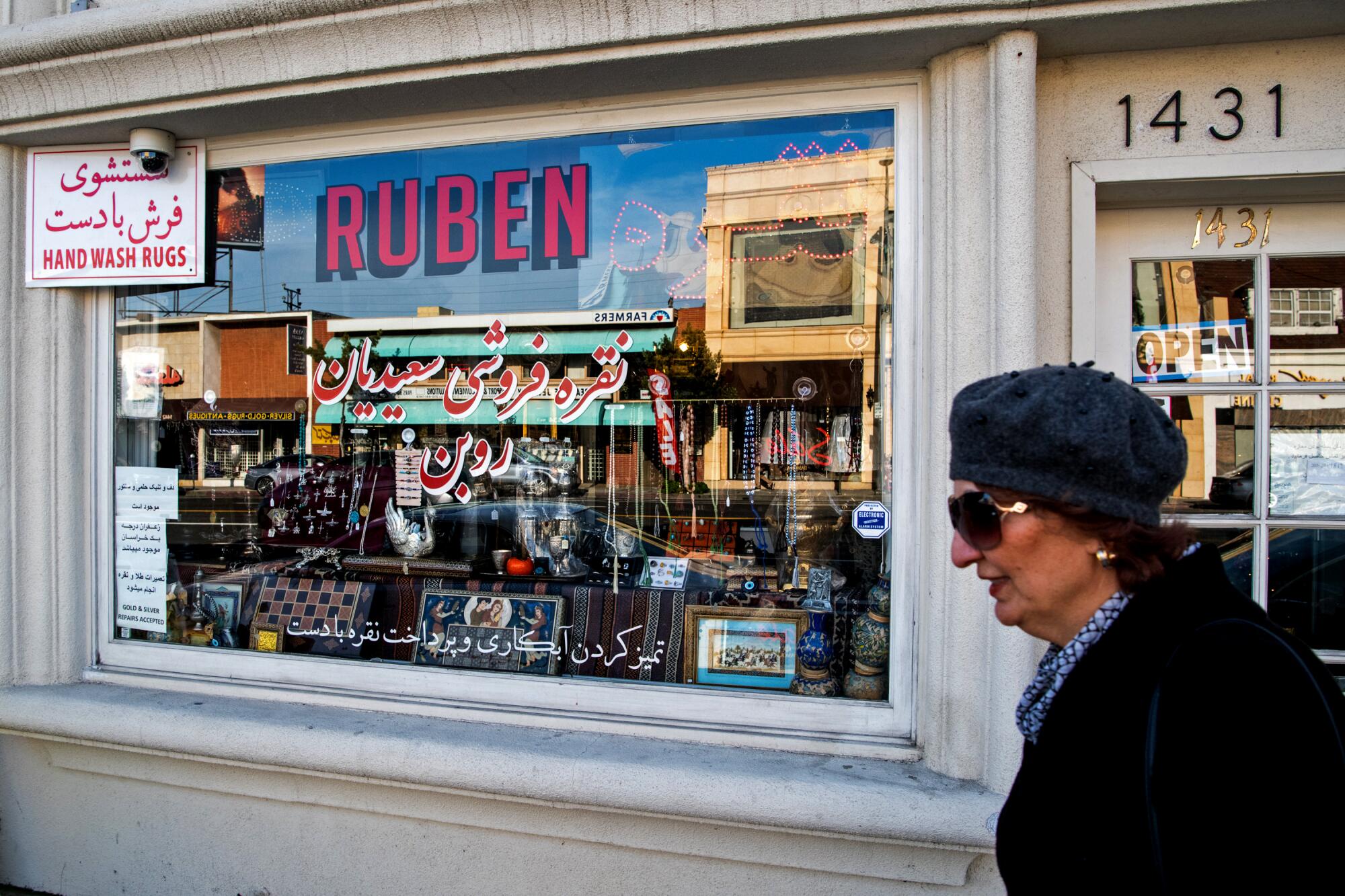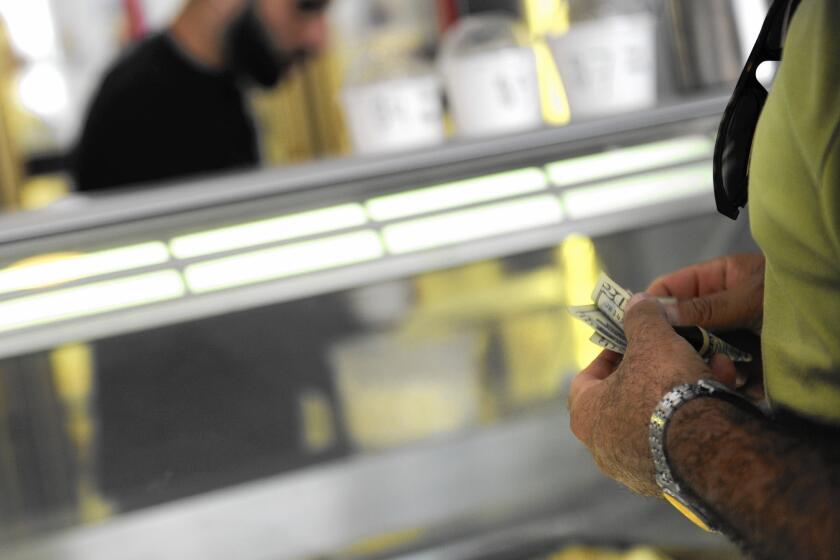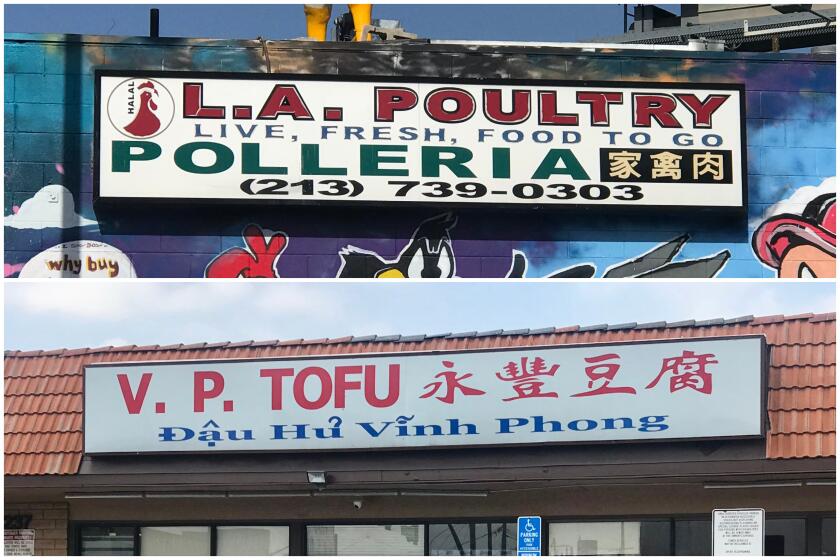
- Share via
Once upon a time, I was a Rodeo Drive shopgirl. I knew the 90210 climes from my childhood visits to the area, along with Westwood and other parts of L.A. we Iranian diasporans called “Tehrangeles.” Back then, I was there to eat kabob lunches with my family, not run the register of a boutique selling five-figure luxury handbags. In this job, I realized my people were nothing like me. They were the ones who owned the “Iranian American” optics of the ’80s and ’90s — Armani and Chanel, white BMWs, McMansions in the hills — not my family with discount-store duds, a Ford Pinto and a one-bedroom apartment 45 minutes away in the less desirable corner of the San Gabriel Valley.
Sadra Ford looked out the front window of the Persian cafe and watched people passing by storefront signs in the language of his native Iran.
Twenty years after that Beverly Hills gig, I decided to make a 1% Iranian American family the lead in a novel. One might say I had no business fictionalizing a culture I knew mostly as an observer. Though we share blood, the American aspect of our Iranian American status couldn’t be more distinct. But that was my point: Who gets to tell our stories? Why were Tehrangelenos alone allowed to define what it meant to be Iranian American? There’s danger in giving the most affluent the reins on narratives and how we’re represented. Other stories are just as valid. There was no real reason to see the rest of us as less than or somehow as relegated to the shadows, and yet it took my becoming a writer — and ultimately a writer of their L.A. — to really come to terms with that.
The Battle of the $18 Ice Cream Bill had a certain “Game of Thrones” quality to it.
I grew up feeling very Iranian. I was immersed in the world of my parents and our relatives, Persian TV and books, impromptu Sunday school Persian classes by my dad. Everyone spoke Persian or at worst “Fenglisi,” the hybrid of Farsi and English. Sadaf and Golchin and other Persian brands made up our pantry, and Persian holidays took precedence. I never had to go far to find Iran. I did however have to go far to find Iranian America.
‘Shahs of Sunset’ stirs concerns among Iranian Americans
That the Westside had a monopoly over our imagery did not entirely surprise me. Who isn’t dazzled by the stereotypical L.A. Iranian lifestyle, made famous in the reality TV show “Shahs of Sunset,” of gold and glitter, plastic surgery and trillionaire thirst traps and tricked-out cars and elite lapdogs? At times, even I began to believe this was the authentic representation of our community.
Unlike in many big cities, Los Angeles’ cultural neighborhoods are not exclusive enclaves. They share space with one another and communicate through signage.
My family and I were clearly the outsiders, falling short of the dream and aspiration of making it in the U.S. It was a source of pride to my parents that seemingly a majority of Tehrangelenos were rich — our failure to get to that wasn’t really talked about, coated in shame and waved off as bad luck.
But there’s something about being shut out of a world that also motivates you to redefine it. With the disdain of the Iranian American Rodeo boutique shoppers fresh in my head — especially when they realized I was one of them, on a cellular level — and even the memory of fellow restaurant patrons irked by our lower-class vibe, I set out to write something deeper than a revenge narrative: a satire about a world adjacent to mine.
It took approaching midlife to understand how much the negative space between us and them had shaped me, how much class had become central to my identity. That distance gave me the gift of perspective. I felt like instead of contributing more to the trauma porn that often became the Western lens on the Middle East, why not tell the story of the most invulnerable — and in too many ways, unsympathetic — Iranian Americans of them all? The Iranians who had let their Americanness take over in a way that beat other Americans at their own game? I decided to use my observer’s distance as a way of taking in the entirety and enormity of their never-ending spectacle.
The post-Shah diaspora is now 40-plus years old — pretty much as old as me — and not what it used to be. And the stories we are telling about ourselves are shifting. Poet Kaveh Akbar’s acclaimed debut novel “Martyr!” came out this year. He was raised mainly in the Midwest, and his tortured recovering alcoholic protagonist Cyrus is worlds away from the vapid playboys of “Shahs of Sunset.” Khashayar J. Khabushani also had a celebrated debut novel recently with, “I Will Greet the Sun Again.” Khabushani grew up in the San Fernando Valley, in a lower-income reality similar to mine, as detailed in his painful coming-of-age story. On TikTok, “Tara Yummy” is one of the most famous Iranian influencers, with more than 8 million followers; her aesthetic is not so much Persian Barbie as Hot Topic video vixen. And there are Iranian American lesbian characters on the show “The L Word” (with actors Sepideh Moafi and Arienne Mandi).
Have we — the real “we” — arrived? I’ve been exploring this very question for years in my writing, and the answer is always we shall see. But I’ve seen the most growth in the past few years, mostly with this generation, Gen Z. It’s through imagining my childhood in them, as I do in my book, and conversely placing them as figures in my own past, that I can find hope. What happens when assimilation anxiety is no longer the hurdle? What happens when identity struggles go past borders and nations and even simple labels? We just may be on the cusp of a real breakthrough, or so we have to tell ourselves.
Porochista Khakpour is an author based in New York City. Her fifth book, the novel “Tehrangeles,” will be published in June.
More to Read
A cure for the common opinion
Get thought-provoking perspectives with our weekly newsletter.
You may occasionally receive promotional content from the Los Angeles Times.










